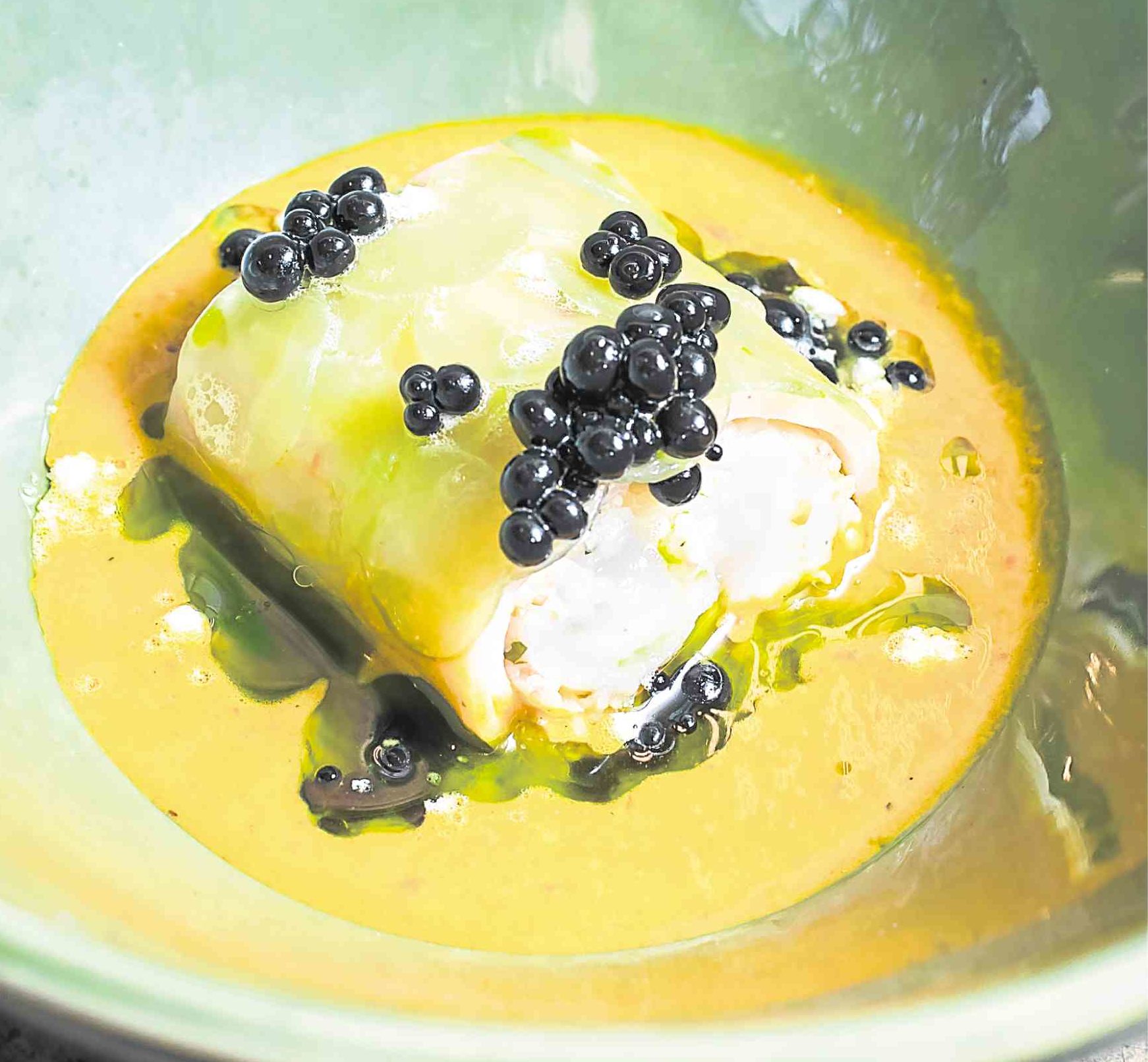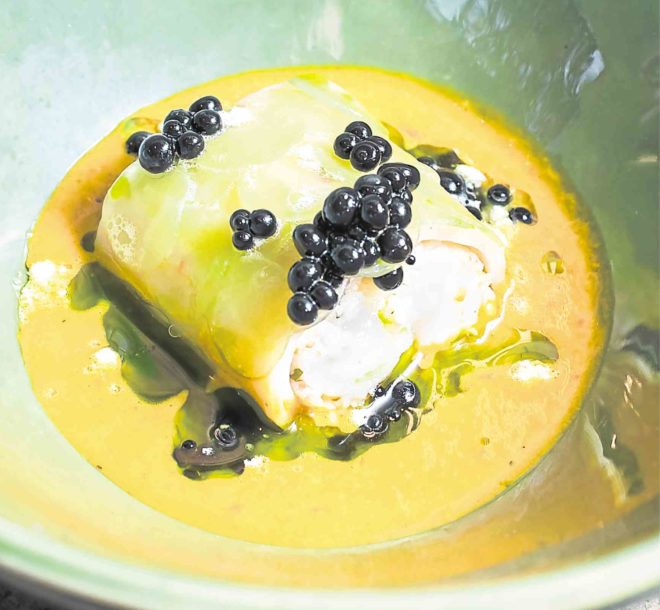
They say that nothing brings people together than good food. And so, in celebration of the 31st Association of Southeast Asian Nations (Asean) Summit, here are some of Manila’s noted chefs reimagining the participating countries’ national dishes.
Singapore’s ‘laksa’ by Nicco Santos
Nicco Santos’ restaurants, Your Local and Hey Handsome, are a testament to his familiarity with Asian flavors. It’s no mystery that he has converted something straightforward like laksa into an elegant dish with components that surprise—squid ink turned into pearls, cucumber compressed to take the shape of small discs, shrimp made into supple noodles.
Though different in form, the flavors remain close to the original—a feat many fail to achieve, but which Santos does with ease.
Burnt ‘laksa’ with head cream and local ‘lang’ and prawn ‘cheong fun’

To make Kaffir powder, heat 30 grams soya oil along with 5 g Kaffir leaves. Strain mixture. Mix 60 g maltodextrin with infused oil.
To make prawn noodles, puree 500 g prawns, then mix with 8 g agar-agar and 2 g salt, then blend again until smooth. Seal in a vacuum bag and flatten mixture. Cook in a sous vide machine at 54°C for 3 minutes. Cut into desired shape.
For the cucumber buttons, peel 300 g shaved cucumber, then place in a vacuum bag with 300 g cucumber juice. Vacuum for at least 25 seconds, then place in a chiller overnight.
For the laksa with burnt coconut sauce, saute 1 kilo of shredded coconut until burnt to a black. Squeeze coconut milk out of it. Set aside. Blend 45 g lemongrass, 450 g red onion, 340 g dried chili, 30 g turmeric, 2 g cumin and 50 g prawn paste. Puree until pasty. Sauce this paste in a pan. Add burnt coconut cream. Season.
To make squid ink caviar, chill 240 g soya oil until it sets. Mix 80 g lemon juice, 80 g squid ink and 2.5 g agar-agar. Boil mixture for 3 minutes at 52°C. Place in a syringe to create steady drops.
To make cilantro spinach oil, blend 200 g cilantro leaves, extract juice and strain. Puree cilantro juice with 100 g spinach until smooth. Strain and season.
To assemble, poach a river prawn in melted butter for 3 minutes or until cooked. Stuff it on the cheong fan. Place on plate on a pool of laksa cream. Layer cucumber, dust Kaffir then place citrus caviar on top.
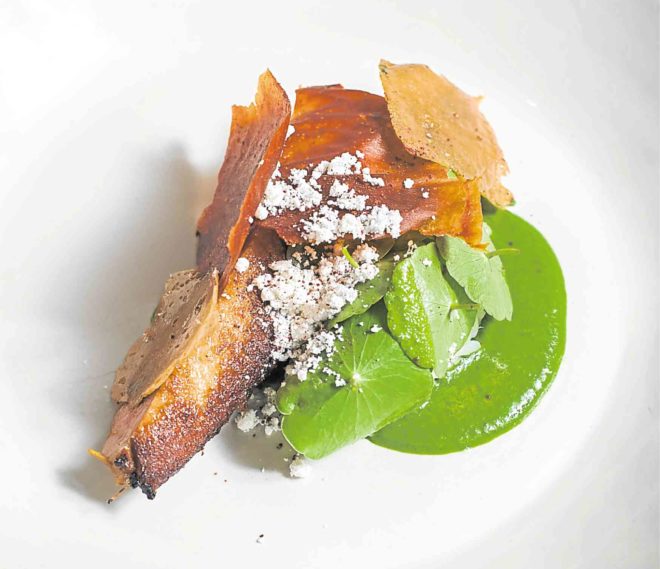
Malaysia’s ‘nasi lemak’ by Nicco Santos
Santos also loves to play around with textures, as shown in his version of nasi lemak—a dusting of Kaffir lime powder here, a quenelle of nasi lemak glutinous rice there, a pool of deep emerald-color cilantro sauce elsewhere. To round up the ensemble, he makes onion and tomato sambal crisp and peanut and dulong shard since, he said, “there’s no more fried element and I want it to still have some crunch.”
Seared duck with rich coconut rice with samba ‘tumis’ and ‘ikan bilis’ crisps
To make coconut rice, mix 180 g jasmine rice, 120 g malagkit rice, 50 g water and 200 g coconut cream. Place in a square pan, then cook for 185°C for about 30 minutes. Season.
To make cilantro and spinach sauce, blend 200 g cilantro leaves, extract juice and strain. Puree cilantro juice with 100 g spinach until smooth. Strain and season.
To make beetroot powder, boil 100 g beets until soft. Pat dry and place in a dehydrator for 6 hours. Blend and strain until powdery in texture.
To make sambal crisp, blend 50 g lemongrass, 50 g ginger, 330 g red onion, and 30 g garlic until pasty. Sauce paste until cooked and add 250 g tomatoes. Season.
To make dilis and mani crisp, melt 250 g isomalt, then, while hot, sprinkle 50 g fried dilis and 50 g mani on top. Place in a hand blender until it turns into powder. Place on top of isomalt, and into an oven at 150°C for 2 minutes. Let rest and chill.
To assemble, blend 20 g lemongrass, 10 g red onions, 10 g turmeric and 8 g ginger until pasty. Place 1 piece duck breast in a sous vide bag with lemongrass paste. Vacuum for at least 30 seconds, then cook sous vide at 56°C for 2 hours. Pan dry duck until skin is crispy. Place a pool of cilantro sauce on a plate. Put coconut rice, followed by the seared duck, layered crisps, then dust with Kaffir and beetroot powders.

Thailand’s pad Thai by Francis Lim
Chef Francis Lim is pretty knowledgeable and eloquent when it comes to food from Thailand. Not only did he study the cuisine and worked in People’s Palace and Benjarong restaurants, he also has been cooking delicious curries and noodles at his own food joint, Nav. His pad Thai is exactly how you’d have it in the streets of Bangkok, but this, his reinterpretation of the dish, comes plated like an instant noodle composed of cooked wheat noodles, satay oil, a thick tamarind sauce, crushed peanuts, crumbled chicken skin and homemade shrimp powder.
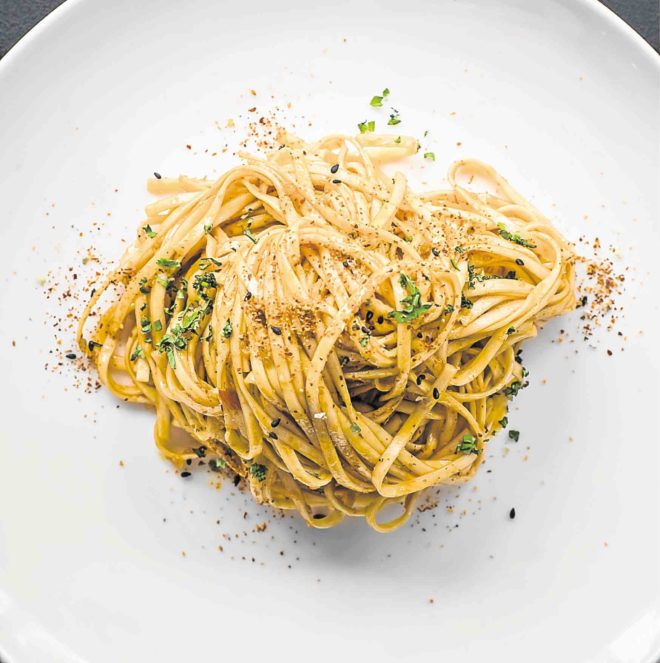
Pad Thai instant noodle
To make tamarind paste, combine 4 tablespoons water, 2 tbsp fresh tamarind, 2 tbsp fish sauce, 2 tbsp light soy sauce, 2 tbsp dark soy sauce, and 4 tbsp palm sugar in a small pot. Simmer at low heat until pasty. Set aside.
To make dried shrimp powder, season 50 g shrimp with salt. Fry in oil until crispy. Let cool. Place on a flat tray and leave to dry. Once dry, place in a mortar and pestle and ground to a semi fine powder. Set aside.
To make chicken peanut powder, season 50 g chicken skin and deep-fry until crispy. Place on a flat tray and leave to dry along with 50 g dry roasted peanuts. Once dry, place in a mortar and pestle and ground to a semifine powder. Set aside.
To assemble, boil 200 g wheat noodles as per cooking instructions. Strain while hot, then mix in the tamarind paste and powders. Top with fried egg and douse with sriracha, if desired.
Cambodia’s fish ‘amok’ by Francis Lim
Typically, this classic Khmer dish is steamed and served on a banana leaf. But Lim’s creativity takes things up a notch by dividing it into its components and presenting it in a more palatable and appetizing manner. The result is beautiful—a mound of orange-hued spicy fish curry sitting on coconut gel—and the taste cleaner and more distinctive.
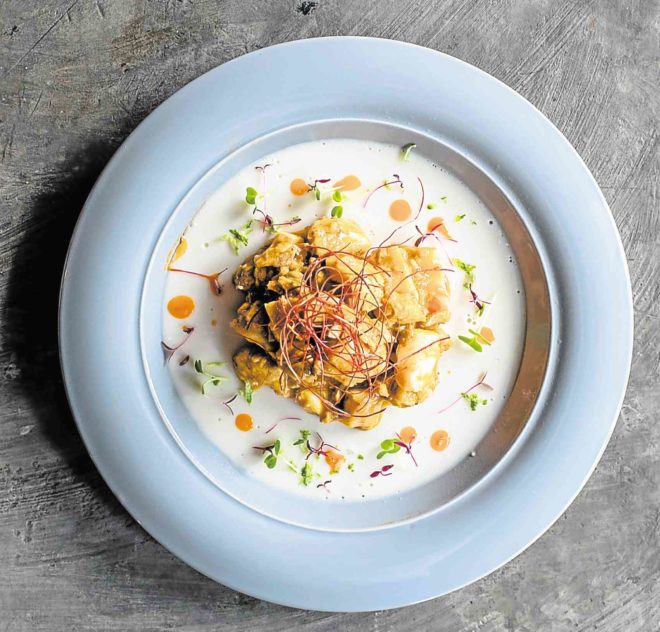
Chilled fish curry
To make coconut gel, combine 1 tsp gelatin powder and ¼ c cold fish stock. Set aside to bloom. In a pot, heat ½ c coconut cream, 1 tsp sugar and 1 tbsp fish sauce. Stir until sugar is dissolved. While warm, add gelatin mixture. Stir well. Let cool. Add 1 tbsp lime juice and 1 tsp finely chopped zest, then pour on a shallow plate. Allow to set.
To make fish curry, fry 2 tbsp red curry paste in a tablespoon each of cooking oil and coconut cream. Add ½ tsp palm sugar, 2 tbsp fish sauce and 4 pieces Kaffir lime leaves. Fry 200 g white fish in paste until cooked, adding ½ c coconut cream gradually. Let cool. Place in chiller along with coconut gel.
To assemble, scoop fish curry and gently place on coconut gel. Top with coriander leaves and chili threads. —CONTRIBUTED

